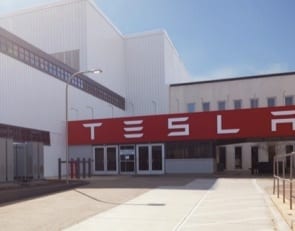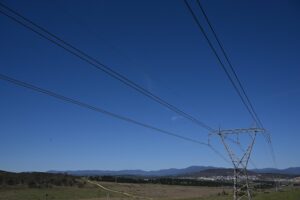Tesla CTO JB Straubel was the keynote speaker at the annual energy storage symposium put on by Joint Venture Silicon Valley this week. He was previously the CTO of Volacom, is a Stanford grad and sits on SolarCity’s board. Long before joining Tesla, Straubel built a record-setting electric Porsche 944.
Electric vehicle batteries
“I really love batteries. I might love batteries more than cars.”
Straubel emphasized the speed at which battery performance is improving, pointing out that the state of the art for EVs in the 1990s was lead-acid batteries. “Lithium-ion changed the game” in range, energy density and cycle life, according to the CTO, who added, “That was the catalyzing event that launched Tesla.” He continued: “In 2003, no one was doing lithium-ion batteries for consumer cars,” and now, “almost every automaker has a lithium-ion” vehicle in their roadmap. He called the improvements in battery technology over the last ten years “amazing.”
Straubel spoke of challenging the internal combustion engine on its “home turf of racing vehicles” with the Roadster. “The Roadster was the biggest battery pack in a vehicle and people were terrified by a 50-kilowatt-hour battery pack. Now, that seems like old technology; it has improved a lot since then.” He noted that in the five years between the launch of the Roadster and the Model S, battery performance had improved by 40 percent. He said that battery energy density has doubled over the last ten years and that the curve is not starting to plateau.
Straubel said that the roadmap for Tesla has always been “EVs for the mass market. We weren’t founded to make sports cars; we were founded to drive a revolution,” adding, “You have to sell millions of cars to move the needle.”
He couldn’t disclose the cost of the Model S battery but said that it was “at a cost point imminently competitive outside of cars.”
Scaling up with the Giga factory
“Maybe this whole group is not thinking in large enough scale for the market size of energy storage.”
Straubel said that it doesn’t require “too much napkin math” to see how 500,000 Gen 3 vehicles per year from the existing Fremont factory will start adding up to gigawatt-hours of battery requirements. Tesla expects to use almost 10 percent of global lithium-ion battery capacity today with its 3 or 4 gigawatt-hours of consumption. Tesla’s expected volumes by 2020 “break the model for lithium-ion capacity,” said the CTO.
The CTO spoke of attacking the battery’s cost with the Giga factory by “doubling the worldwide capacity in a single factory and reinventing the supply chain.” He said that Tesla would be “breaking ground in the next few weeks.” A total of 35 gigawatt-hours of cell production from the new plant will be devoted to meeting the needs of the Fremont plant, and 15 gigawatt-hours will be devoted to stationary battery packs. Straubel said that Tesla was “bullish” about the California energy storage mandate. Straubel also said he was bullish that stationary energy storage “can scale faster than automotive.”
Battery technology
“We should all be thinking bigger.”
The CTO suggested that lithium-ion battery technology would dominate “for five, maybe ten years.”
He said that there will be improvements in cathode, anode and electrolyte materials, but that for the next five or ten years, things will look pretty much the same. There was little reason to battle about the size of the cell or the 18650 form factor, in the CTO’s view. The improvements to the cell will come with better anode and cathode material, not with the shape and size of the cell.
Stationary storage integrating renewables
“We are an energy innovation company as much as a car company.”
That was Straubel’s response when asked why Tesla is involved in stationary energy storage. He said that residential battery packs have the “same architecture” as vehicle batteries.
He noted that since last year, a 2 megawatt-hour battery pack has been helping to manage loads at the Fremont Tesla factory, managing 10 percent of peak demand. “It’s still a small pack,” said Straubel. “The scale we need to operate on is so much bigger than that.” The installation will be expanded to 4 megawatt-hours in the next three to four months.
“We’ve started piloting these applications,” said the CTO, pointing out that there is a 400 kilowatt-hour battery pack at the Tejon Ranch supercharger site in Southern California. The “supercharger is the perfect application for energy storage” with its “incredibly peaky load,” he added.
Stationary applications are much easier to design for from a vibration, thermal and charge profile standpoint compared to an automobile. He said, “The [energy storage] market is going to grow faster than people think,” although “the value of backup power is hard to quantify.”
Tesla is “experimenting with aggregating the systems at a number of different houses that can dispatch batteries to market signals” in a look at “behind-the-meter aggregation,” Straubel said. The challenge is “how you make a business case to the customer” and then get paid by an ISO or utility for the services. Straubel also said the market was “not yet fully baked.”
The CTO spoke of the duck curve, saying it would look tame at 20 percent renewable penetration compared to what happens with more renewables on the grid.
“How do you enable super-high density of renewables on the grid? That’s what drives storage over the next decade,” said the CTO.
“We are not thinking big enough,” said Straubel.
This article was originally published by Greentech Media. Reproduced with permission











